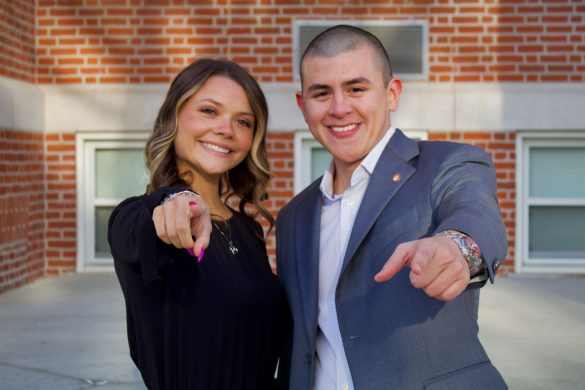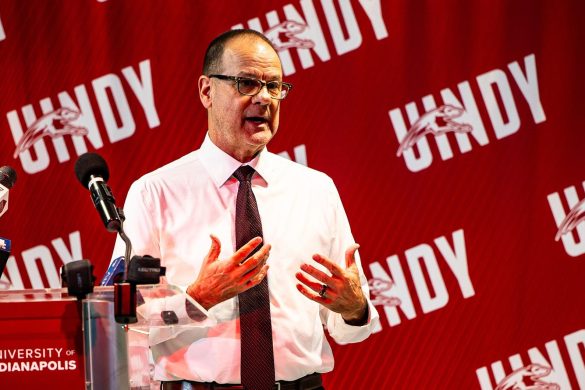Starting in December, the University of Indianapolis will begin the building process for the new campus apartments expected to be available to residents in January 2019.
The new apartments will be in two buildings with around 300 beds and located on National Avenue to the west of the athletic practice field.
According to University President Robert Manuel, the building process will begin with making sure the land is ready, starting with the removal of houses, setting up drainage, laying down concrete and finishing the underground work needed for the buildings to be put up. Finishing the rest of the building, once the underground work is completed, is expected to take between nine months and a year.
According to Vice President for Student and Campus Affairs and Dean of Students Kory Vitangeli, once the buildings are completed, the application process will be similar to that of Greyhound Village and will be available for students to sign up this upcoming spring semester. The university plans to allow students to sign up for one semester on campus and then move into the new apartments the second semester, Vitangeli said.
“It’s an exciting option for upperclass students as they look to sign up for housing, and students will be able to sign that six-month lease or an 18-month lease to allow them to stay all the way through the following year,” Vitangeli said. “We’re excited about getting floor plans and having some models built so that students can see what this looks like. I think it will be very similar to Greyhound Village—one, two, and four bedroom apartments that look very similar to Greyhound Village—and so we’re really excited about the addition on campus.”
The success of Greyhound Village is why the new apartments will function and look similar. The model for the new apartments will not consist of an actual model like Greyhound Village but will instead focus on more virtual models to allow students to see what living there will be like. Employees will be from the Residence Halls Association and similar to Greyhound Village Assistants.
The demand for more space for upperclassmen to live on campus was one of the factors considered in deciding that the new building would be an apartment complex rather than a new residence hall, according to Manuel.
“We’ve had a large increase in the number of juniors and seniors that want to live on campus and want to be engaged in the life of campus,” Manuel said. “We’ve had larger numbers in our retention rates, so the numbers of students that return year-to-year are going up, and they want to be on campus. We’ve been able to have healthy populations of new students come in each year. So there’s a demand for the kind of education that we’ve been creating, which is intensive, connected and requires you to be in community with people, and that’s the demand.”
Besides the demand for more space for upperclassmen, the new apartments are also intended to help students understand the process of living on their own by helping them understand leases and allowing them an opportunity for more independent living.
“We’re trying to help the maturation of the students,” Manuel said. “As you come through high school to live in a residence hall setting like Cory Bretz, Warren or any of those buildings, they are more [of a] community to help people socialize and help people integrate with the community that’s here. Before you move out after graduation, you need to have more freedom to explore what that’s like. There are these stages that occur on campus that allow our students to become independent, at first and have some support and then move into more independent living situations, to become more independent so that once you graduate and move out you’re not figuring out, what a lease looks like or what all that personal responsibility is.”
The new apartments also will allow the campus to expand, according to Manuel. The addition of Greyhound Village expanded the west side of campus, and the Health Pavilion stretched the east side.
Because the University Heights neighborhood is the founding neighborhood, the university agreed to not expand the campus to the south, so the next step was to expand to the north, Manuel said.
According to Vitangeli, the new addition will increase students’ desire to live on campus by turning the campus’ footprint into more of a neighborhood and allowing students to feel at home.
“The university is always looking to expand its footprint. So, one of the areas of property that we owned that was possible to [use to] expand campus housing was back on National [Avenue],” Vitangeli said. “When you look at the campus footprint, there is not a lot of open space on which we can build, and so this one extended the campus. We’ve already gone back on National [Avenue] to add the athletics practice field, and we built Greyhound Village kind of perpendicular to National [Avenue], so it seemed like a likely place to expand student housing because it really makes, now, kind of a neighborhood feel. When you look at the back of those residence halls, you have the baseball field, the softball field, the lacrosse field and now Greyhound Village on the back end, and it makes kind of a little campus neighborhood back there.”
The new addition will allow the university to fulfill its mission and maintain its tradition of helping the students to perform better academically, according to Manuel.
“If you think of traditional freshmen, they come in in August and move out in May. And then June, July and August, there is nobody in there [the dorms],” Manuel said. “So they’re not living with us for all of the 10 months, which means that they’re not here to eat at a restaurant, buy things at grocery store or use public transportation. The density of the place, in terms of the number of people that live here, waxes and wanes. We have these living arrangements that are 12 months now, and then people start living here during the summer, and they need to buy food, eat at the restaurants and take public transportation. So one thing is that it increases the density in the area, which is more attractive to a developer who might want to put in a restaurant or a store…. One of our main pieces of the Vision 2030 work that we’ve been doing is to raise the quality level of life for everybody in the area. And having places to go to that aren’t just fast food is helpful for a community that wants to have a high quality of life.”
According to Manuel, as of now, the new building does not have a name and the university would like help from the campus community in naming it. Students, faculty and staff can tweet names they believe represent the university, its history and its tradition.









